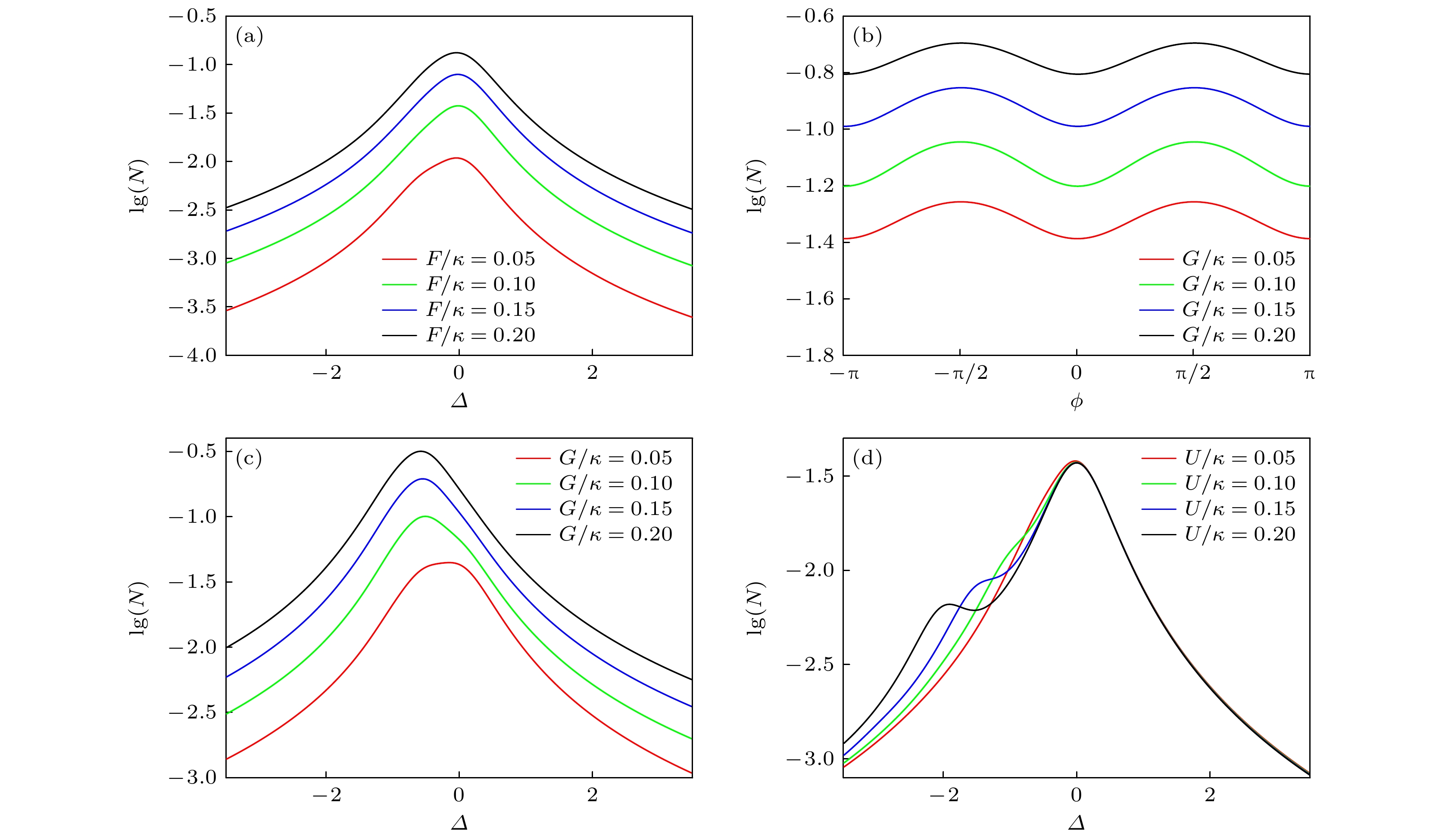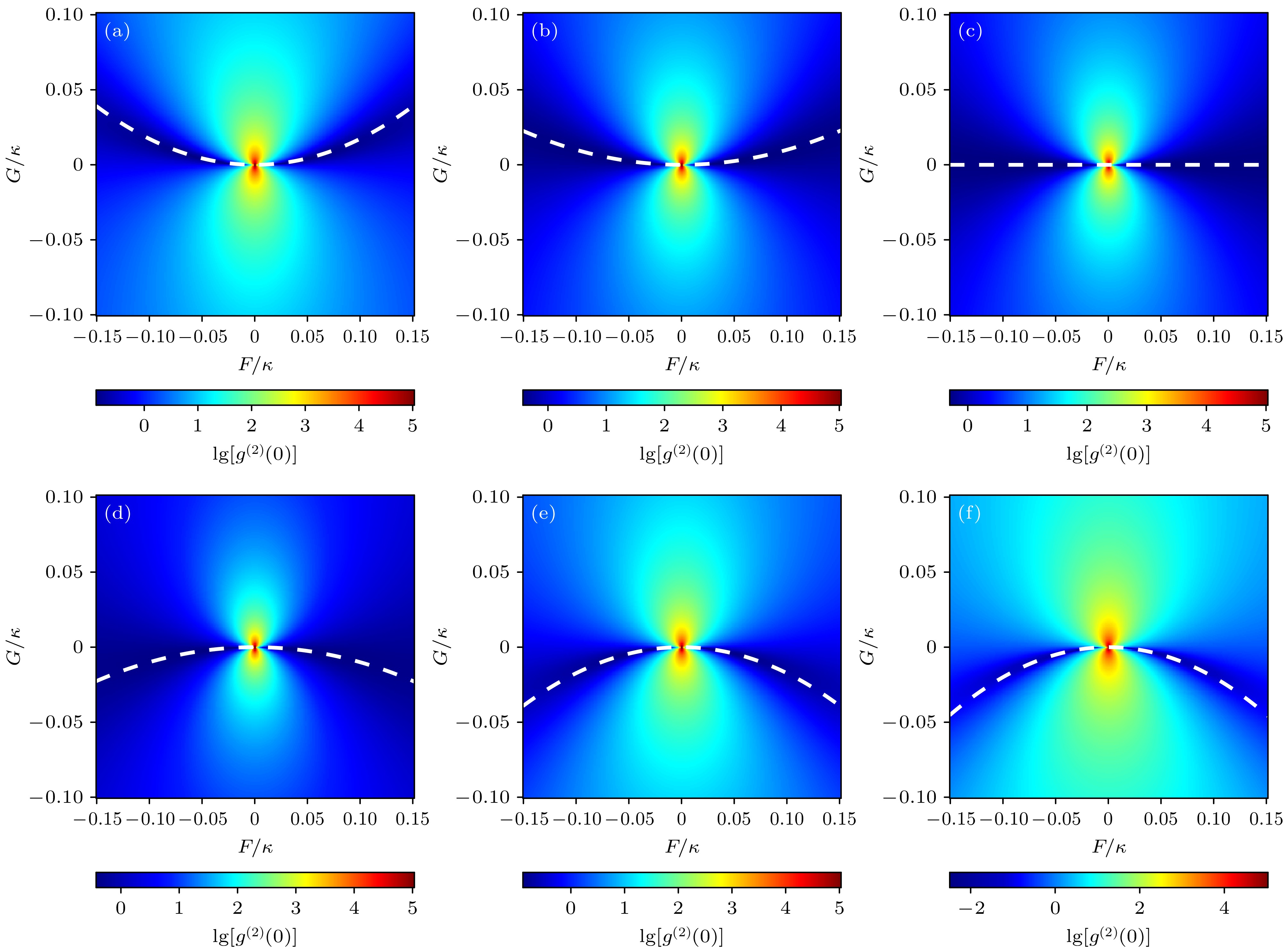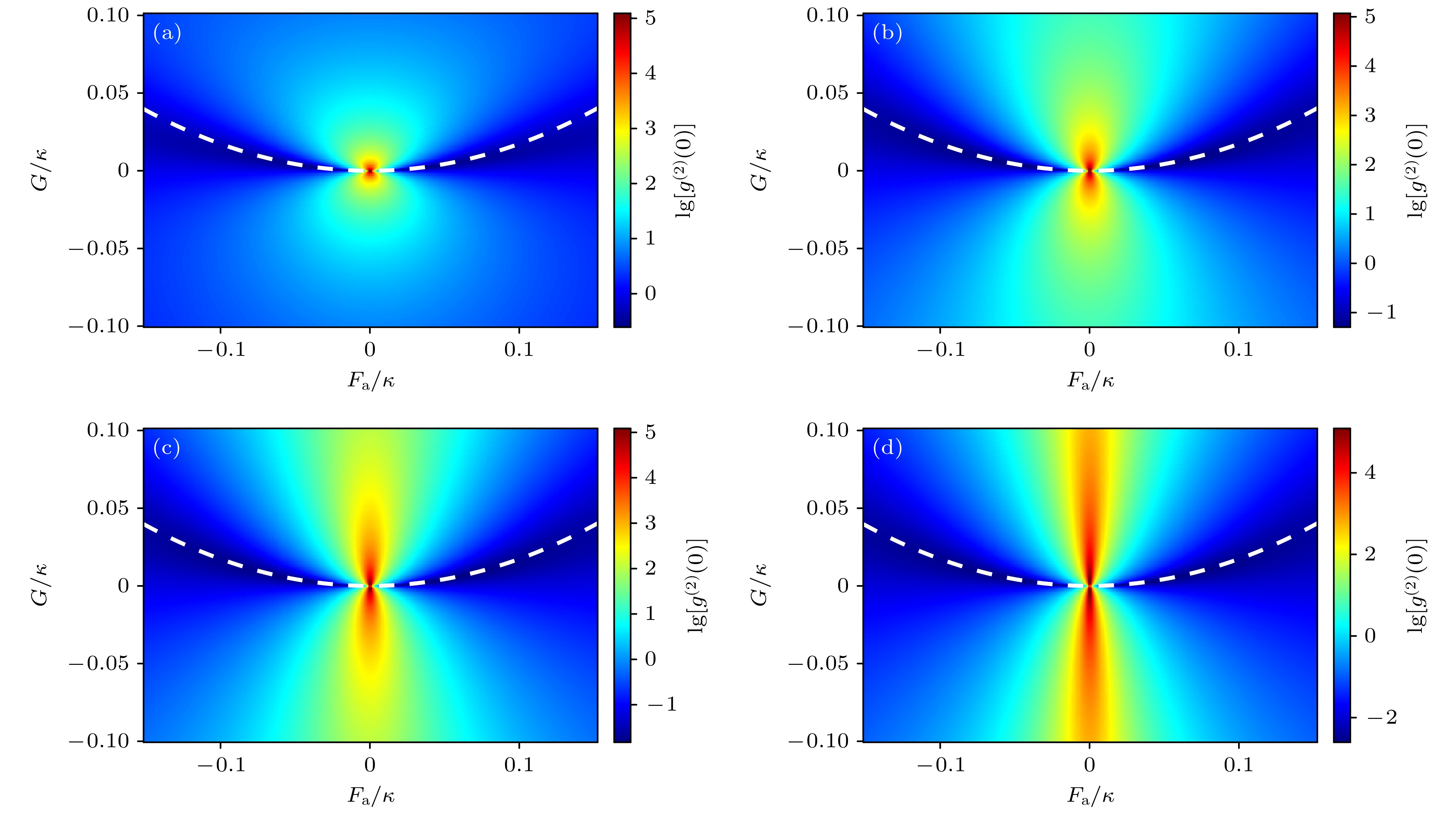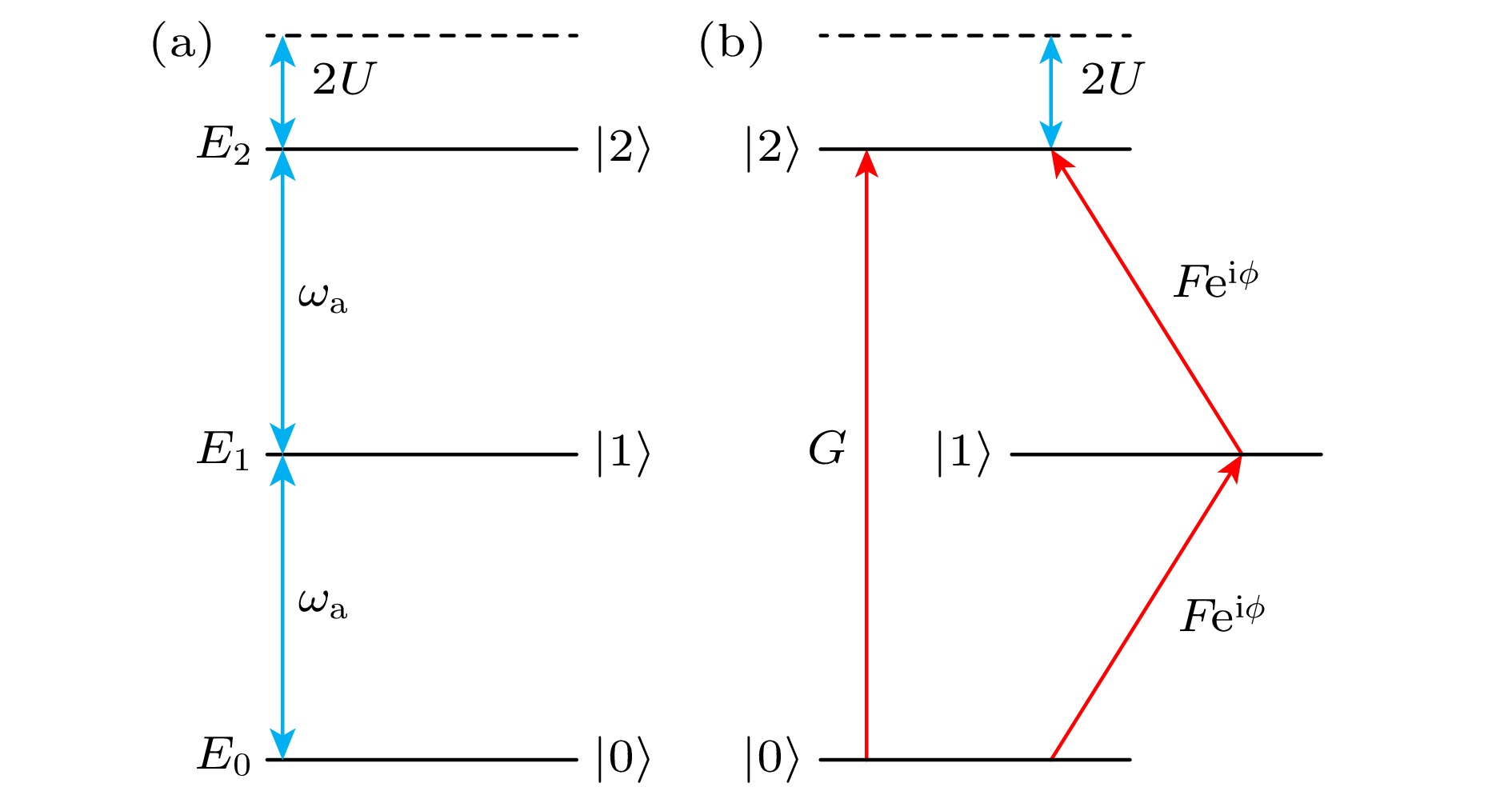-
By combining analytical solutions and numerical simulations, we investigate the control mechanism of photon blockade effects in a hybrid quantum system consisting of a Kerr-medium single-mode cavity coupled with an optical parametric amplifier (OPA). To study photon blockade in the system, the dynamics are described by a master equation derived from the effective Hamiltonian, which considers single-mode cavity decay. In order to obtain analytical solutions under optimal photon blockade conditions, the quantum state of the system is expanded to the two-photon level based on the Fock state, and the steady-state probability amplitudes are derived by solving the Schrödinger equation, thereby yielding analytical expressions for the optimal photon blockade regime. The results demonstrate that photon blockade can be achieved in the system at appropriate parameters. Comparative analysis shows excellent agreement between the analytical results and numerical simulations of the equal-time second-order correlation function, validating both the correctness of the analytical solutions and the effectiveness of photon blockade in the system. The numerical results show that the average photon number significantly increases under resonant conditions, providing theoretical support for optimizing single-photon source brightness, which is essential for achieving high-brightness single-photon sources. Furthermore, variations in the driving phase can cause the optimal photon blockade region to shift in the two-dimensional parameter space of driving strength and OPA nonlinear coefficient, and even reverse the opening direction of the parabolic-shaped optimal blockade region. Both numerical and theoretical results confirm the regulatory effect of the driving phase on photon blockade. Additionally, the influence of Kerr nonlinearity is examined. The results show that photon blockade persists robustly over a broad range of Kerr nonlinear strengths, exhibiting universal characteristics. Physical mechanism analysis indicates that the photon blockade effect originates from destructive quantum interference between two photon transition pathways in the system under specific parameters, effectively suppressing two-photon excitation. Although Kerr nonlinearity modulates the energy levels of the system, it does not affect the quantum interference pathways, thus keeping the photon blocking effect stable over a wide parameter range. [1] Zubizarreta Casalengua E, López Carreño J C, Laussy F P, Valle E D 2020 Laser Photonics Rev. 14 1900279
 Google Scholar
Google Scholar
[2] Lu Z G, Wu Y, Lü X Y 2025 Phys. Rev. Lett. 134 013602
 Google Scholar
Google Scholar
[3] Birnbaum K M, Boca A, Miller R, Boozer A D, Northup T E, Kimble H J 2005 Nature 436 87
 Google Scholar
Google Scholar
[4] Snijders H J, Frey J A, Norman J, Flayac H, Savona V, Gossard A C, Bowers J E, Van Exter M P, Bouwmeester D, Löffler W 2018 Phys. Rev. Lett. 121 043601
 Google Scholar
Google Scholar
[5] Vaneph C, Morvan A, Aiello G, Féchant M, Aprili M, Gabelli J, Estève J 2018 Phys. Rev. Lett. 121 043602
 Google Scholar
Google Scholar
[6] Ding X, Guo Y P, Xu M C, Liu R Z, Zou G Y, Zhao J Y, Ge Z X, Zhang Q H, Liu H L, Wang L J, Chen M C, Wang H, He Y M, Huo Y H, Lu C Y, Pan J W 2025 Nat. Photonics 19 387
 Google Scholar
Google Scholar
[7] Zhou Y H, Zhang X Y, Wu Q C, Ye B L, Zhang Z Q, Zou D D, Shen H Z, Yang C P 2020 Phys. Rev. A 102 033713
 Google Scholar
Google Scholar
[8] Wang Z X, Yang H, Wang X Q, Lin H Y, Yao Z H 2023 Phys. Scr. 98 035108
 Google Scholar
Google Scholar
[9] Lin H Y, Wang X Q, Yao Z H, Zou D D 2020 Opt. Express 28 17643
 Google Scholar
Google Scholar
[10] Bamba M, Imamoğlu A, Carusotto I, Ciuti C 2011 Phys. Rev. A 83 021802
 Google Scholar
Google Scholar
[11] Flayac H, Savona V 2017 Phys. Rev. A 96 053810
 Google Scholar
Google Scholar
[12] Shen H Z, Yang J F, Yi X X 2024 Phys. Rev. A 109 043714
 Google Scholar
Google Scholar
[13] Sun J Y, Shen H Z 2023 Phys. Rev. A 107 043715
 Google Scholar
Google Scholar
[14] Liew T C H, Savona V 2010 Phys. Rev. Lett. 104 183601
 Google Scholar
Google Scholar
[15] Imamoḡlu A, Schmidt H, Woods G, Deutsch M 1997 Phys. Rev. Lett. 79 1467
[16] 李宏, 张斯淇, 郭明, 李美萱, 宋立军 2019 物理学报 68 124203
 Google Scholar
Google Scholar
Li H, Zhang S Q, Guo M, Li M X, Song L J 2019 Acta Phys. Sin. 68 124203
 Google Scholar
Google Scholar
[17] Li M, Zhang Y L, Wu S H, Dong C H, Zou X B, Guo G C, Zou C L 2022 Phys. Rev. Lett. 129 043601
 Google Scholar
Google Scholar
[18] Ridolfo A, Leib M, Savasta S, Hartmann M J 2012 Phys. Rev. Lett. 109 193602
 Google Scholar
Google Scholar
[19] Zhou Y H, Shen H Z, Zhang X Y, Yi X X 2018 Phys. Rev. A 97 043819
 Google Scholar
Google Scholar
[20] Zhu H Y, Li X M, Li Z G, Wang F, Zhong X L 2023 Opt. Express 31 22030
 Google Scholar
Google Scholar
[21] Shen H Z, Zhou Y H, Yi X X 2015 Phys. Rev. A 91 063808
 Google Scholar
Google Scholar
[22] Zhou Y H, Shen H Z, Yi X X 2015 Phys. Rev. A 92 023838
 Google Scholar
Google Scholar
[23] Zhou Y H, Liu T, Zhang X Y, Wu Q C, Chen D X, Shi Z C, Yang C P 2024 Adv. Quantum Technol. 7 2400089
 Google Scholar
Google Scholar
[24] Chakram S, He K, Dixit A V, Oriani A E, Naik R K, Leung N, Kwon H, Ma W L, Jiang L, Schuster D I 2022 Nat. Phys. 18 879
 Google Scholar
Google Scholar
[25] Zhang W, Liu S T, Zhang S, Wang H F 2023 Adv. Quantum Technol. 6 2300187
 Google Scholar
Google Scholar
[26] Li H J, Fan L B, Ma S, Liao J Q, Shu C C 2024 Phys. Rev. A 110 043707
 Google Scholar
Google Scholar
[27] Ding Z, Zhang Y 2022 Chin. Phys. B 31 070304
 Google Scholar
Google Scholar
[28] Li H, Liu M, Yang F, Zhang S, Ruan S 2023 Micromachines 14 2123
 Google Scholar
Google Scholar
[29] Luo Y, Zhang X Q, Xiao Y, Xu J P, Li H Z, Yang Y P, Xia X W 2025 Chin. Phys. B 34 14203
 Google Scholar
Google Scholar
[30] Huang R, Miranowicz A, Liao J Q, Nori F, Jing H 2018 Phys. Rev. Lett. 121 153601
 Google Scholar
Google Scholar
[31] Shen H Z, Wang Q, Wang J, Yi X X 2020 Phys. Rev. A 101 013826
 Google Scholar
Google Scholar
[32] Jing Y W, Shi H Q, Xu X W 2021 Phys. Rev. A 104 033707
 Google Scholar
Google Scholar
[33] Zhang X Q, Xia X W, Xu J P, Li H Z, Fu Z Y, Yang Y P 2022 Chin. Phys. B 31 074204
 Google Scholar
Google Scholar
[34] Luan T Z, Yang J X, Wang J, Shen H Z, Zhou Y H, Yi X X 2023 Int. J. Quantum Inf. 21 2350021
 Google Scholar
Google Scholar
[35] Shen H Z, Luan T Z, Zhou Y H, Shi Z C, Yi X X 2023 Int. J. Quantum Inf. 21 2350029
 Google Scholar
Google Scholar
[36] Liu M Y, Gong Y, Chen J J, Wang Y W, Wei X 2025 Chin. Phys. B 34 57202
 Google Scholar
Google Scholar
[37] Wu S X, Gao X C, Cheng H H, Bai C H 2025 Phys. Rev. A 111 043714
 Google Scholar
Google Scholar
[38] Xue W S, Shen H Z, Yi X X 2020 Opt. Lett. 45 4424
 Google Scholar
Google Scholar
[39] Wang D Y, Bai C H, Liu S T, Zhang S, Wang H F 2019 Phys. Rev. A 99 043818
 Google Scholar
Google Scholar
[40] Fan X H, Zhang Y N, Yu J P, Liu M Y, He W D, Li H C, Xiong W 2024 Adv. Quantum Technol. 7 2400043
 Google Scholar
Google Scholar
[41] Chen J J, Fan X G, Xiong W, Wang D, Ye L 2024 Phys. Rev. A 109 043512
 Google Scholar
Google Scholar
[42] Su X, Tang J S, Xia K Y 2022 Phys. Rev. A 106 063707
 Google Scholar
Google Scholar
[43] Xie H, He L W, Shang X, Lin X M 2024 Adv. Quantum Technol. 7 2400065
 Google Scholar
Google Scholar
[44] Tan S M 1999 J. Opt. B 1 424
 Google Scholar
Google Scholar
[45] Tan S M Quantum Optics Toolbox for MATLAB https://github.com/jevonlongdell/qotoolbox [2012-12-21]
[46] 张志强 2025 激光与光电子学进展 62 0719001
 Google Scholar
Google Scholar
Zhang Z Q 2025 Laser Optoelectron. Prog. 62 0719001
 Google Scholar
Google Scholar
[47] Zhang W, Hou R, Wang T, Liu S T, Zhang S, Wang H F 2024 Phys. Rev. A 110 023723
 Google Scholar
Google Scholar
[48] Wang Y, Verstraelen W, Zhang B L, Liew T C H, Chong Y D 2021 Phys. Rev. Lett. 127 240402
 Google Scholar
Google Scholar
[49] Zhou Y H, Liu T, Su Q P, Zhang X Y, Wu Q C, Chen D X, Shi Z C, Shen H Z, Yang C P 2025 Phys. Rev. Lett. 134 183601
 Google Scholar
Google Scholar
-
图 1 等时二阶关联函数$ {g^{\left( 2 \right)}}\left( 0 \right) $的对数随不同物理量之间的变化图像 (a) 等时二阶关联函数${g^{\left( 2 \right)}}\left( 0 \right)$的对数值随驱动力强度${F \mathord{\left/ {\vphantom {F \kappa }} \right. } \kappa }$和光学参量放大器非线性系数${G \mathord{\left/ {\vphantom {G \kappa }} \right. } \kappa }$的变化, 其他参数设置为$\phi = {{\pi} \mathord{\left/ {\vphantom {{\pi} {12}}} \right. } {12}}$和${U \mathord{\left/ {\vphantom {U \kappa }} \right. } \kappa } = 0.5$; (b) ${g^{\left( 2 \right)}}\left( 0 \right)$的对数值光学参量放大器非线性系数${G \mathord{\left/ {\vphantom {G \kappa }} \right. } \kappa }$和驱动力相位${\phi _a}$的变化关系图像, 其他参数设置为${F \mathord{\left/ {\vphantom {F \kappa }} \right. } \kappa } = 0.1$和${U \mathord{\left/ {\vphantom {U \kappa }} \right. } \kappa } = 0.5$. 两幅图中的白色虚线, 由方程(13)给出, 表示光子阻塞最佳条件的解析结果
Figure 1. Logarithmic value of the equal-time second-order correlation function $ {g^{\left( 2 \right)}}\left( 0 \right) $ versus different physical parameters are presented: (a) Logarithmic value of $ {g^{\left( 2 \right)}}\left( 0 \right) $ as a function of the driving strength $ {F \mathord{\left/ {\vphantom {F \kappa }} \right. } \kappa } $ and the nonlinear coefficient $ {G \mathord{\left/ {\vphantom {G \kappa }} \right. } \kappa } $ of the optical parametric amplifier, where $ \phi = {{\pi} \mathord{\left/ {\vphantom {{\pi} {12}}} \right. } {12}}$ and ${U \mathord{\left/ {\vphantom {U \kappa }} \right. } \kappa } = 0.5$; (b) logarithmic value of $ {g^{\left( 2 \right)}}\left( 0 \right) $ as a function of the nonlinear coefficient $ {G \mathord{\left/ {\vphantom {G \kappa }} \right. } \kappa } $ and the driving phase $ \phi $, where ${F \mathord{\left/ {\vphantom {F \kappa }} \right. } \kappa } = 0.1$ and ${U \mathord{\left/ {\vphantom {U \kappa }} \right. } \kappa } = 0.5$. In both figures, the white dashed lines, derived from Eq. (13), indicate the analytical solutions corresponding to the optimal conditions for photon blockade.
图 2 系统的平均光子数的对数$ \lg \left( N \right) $随不同参数的变化 (a) 不同驱动力强度${F \mathord{\left/ {\vphantom {F \kappa }} \right. } \kappa }$下, $ \lg \left( N \right) $随失谐量${\varDelta \mathord{\left/ {\vphantom {\varDelta \kappa }} \right. } \kappa }$的变化; (b) 不同光学参量放大器非线性系数${G \mathord{\left/ {\vphantom {G \kappa }} \right. } \kappa }$下, $ \lg \left( N \right) $随驱动力相位$\phi $的变化; (c) 不同光学参量放大器非线性系数${G \mathord{\left/ {\vphantom {G \kappa }} \right. } \kappa }$下, $ \lg \left( N \right) $随失谐量${\varDelta \mathord{\left/ {\vphantom {\varDelta \kappa }} \right. } \kappa }$的变化; (d) 不同克尔非线性强度${U \mathord{\left/ {\vphantom {U \kappa }} \right. } \kappa }$下, $ \lg \left( N \right) $随失谐量${\varDelta \mathord{\left/ {\vphantom {\varDelta \kappa }} \right. } \kappa }$的变化
Figure 2. Logarithmic value of the average photon number $ N $ versus different parameters: (a) $ \lg \left( N \right) $ as a function of detuning ${\varDelta \mathord{\left/ {\vphantom {\varDelta \kappa }} \right. } \kappa }$ at different driving strengths ${F \mathord{\left/ {\vphantom {F \kappa }} \right. } \kappa }$; (b) phase dependence of $ \lg \left( N \right) $ under varying of the optical parametric amplifier nonlinear coefficients ${G \mathord{\left/ {\vphantom {G \kappa }} \right. } \kappa }$; (c) detuning dependence of $ \lg \left( N \right) $ for different optical parametric amplifier nonlinear coefficients ${G \mathord{\left/ {\vphantom {G \kappa }} \right. } \kappa }$; (d) $ \lg \left( N \right) $ versus detuning ${\varDelta \mathord{\left/ {\vphantom {\varDelta \kappa }} \right. } \kappa }$ at distinct Kerr nonlinearity strengths ${U \mathord{\left/ {\vphantom {U \kappa }} \right. } \kappa }$.
图 3 不同驱动力相位$\phi $情况下, 等时二阶关联函数$ {g^{(2)}}(0) $的对数随驱动力强度${F \mathord{\left/ {\vphantom {F \kappa }} \right. } \kappa }$和光学参量放大器非线性系数${G \mathord{\left/ {\vphantom {G \kappa }} \right. } \kappa }$的变化(a) $\phi = {{\pi} \mathord{\left/ {\vphantom {{\pi} {12}}} \right. } {12}}$; (b) $\phi = {{\pi} \mathord{\left/ {\vphantom {{\pi} 6}} \right. } 6}$; (c) $\phi = {{\pi} \mathord{\left/ {\vphantom {{\pi} 4}} \right. } 4}$; (d) $\phi = {{\pi} \mathord{\left/ {\vphantom {{\pi} 3}} \right. } 3}$; (e) $\phi = {{{{5\pi }}} \mathord{\left/ {\vphantom {{{{5\pi }}} {12}}} \right. } {12}}$; (f) $\phi = {{\pi} \mathord{\left/ {\vphantom {{\pi} 2}} \right. } 2}$. 图中的白色虚线由方程(13)给出, 表示光子阻塞最佳条件的解析结果. 克尔非线性强度均设置为${U \mathord{\left/ {\vphantom {U \kappa }} \right. } \kappa } = 0.5$
Figure 3. Logarithmic value of $ {g^{(2)}}(0) $ as a function of the driving strength $ {F \mathord{\left/ {\vphantom {F \kappa }} \right. } \kappa } $ and the nonlinear coefficient $ {G \mathord{\left/ {\vphantom {G \kappa }} \right. } \kappa } $ of the optical parametric amplifier under different driving phases $\phi $: (a) $\phi = {{\pi} \mathord{\left/ {\vphantom {{\pi} {12}}} \right. } {12}}$; (b) $\phi = {{\pi} \mathord{\left/ {\vphantom {{\pi} 6}} \right. } 6}$; (c) $\phi = {{\pi} \mathord{\left/ {\vphantom {{\pi} 4}} \right. } 4}$; (d) $\phi = {{\pi} \mathord{\left/ {\vphantom {{\pi} 3}} \right. } 3}$; (e) $\phi = {{{{5\pi }}} \mathord{\left/ {\vphantom {{{{5\pi }}} {12}}} \right. } {12}}$; (f) $\phi = {{\pi} \mathord{\left/ {\vphantom {{\pi} 2}} \right. } 2}$. In all panels, the white dashed lines, derived from Eq. (13), represent the analytical solutions for the optimal photon blockade conditions. The Kerr nonlinearity strength was consistently set to ${U \mathord{\left/ {\vphantom {U \kappa }} \right. } \kappa } = 0.5$ in the numerical simulations.
图 4 不同克尔非线性强度${U \mathord{\left/ {\vphantom {U \kappa }} \right. } \kappa }$情况下, 等时二阶关联函数$ {g^{\left( 2 \right)}}\left( 0 \right) $的对数随驱动力强度${F \mathord{\left/ {\vphantom {F \kappa }} \right. } \kappa }$和光学参量放大器非线性系数${G \mathord{\left/ {\vphantom {G \kappa }} \right. } \kappa }$的变化图像 (a) ${U \mathord{\left/ {\vphantom {U \kappa }} \right. } \kappa } = 0.1$; (b) ${U \mathord{\left/ {\vphantom {U \kappa }} \right. } \kappa } = 1.0$; (c) ${U \mathord{\left/ {\vphantom {U \kappa }} \right. } \kappa } = 2.0$; (d) ${U \mathord{\left/ {\vphantom {U \kappa }} \right. } \kappa } = 5.0$. 图中的虚线由方程(13)给出, 表示光子阻塞最佳条件的解析结果
Figure 4. Logarithmic value of $ {g^{\left( 2 \right)}}\left( 0 \right) $ as a function of the driving strength $ {F \mathord{\left/ {\vphantom {F \kappa }} \right. } \kappa } $ and the nonlinear coefficient $ {G \mathord{\left/ {\vphantom {G \kappa }} \right. } \kappa } $ of the optical parametric amplifier under different Kerr nonlinearity strength ${U \mathord{\left/ {\vphantom {U \kappa }} \right. } \kappa }$: (a) ${U \mathord{\left/ {\vphantom {U \kappa }} \right. } \kappa } = 0.1$; (b) ${U \mathord{\left/ {\vphantom {U \kappa }} \right. } \kappa } = 1.0$; (c) ${U \mathord{\left/ {\vphantom {U \kappa }} \right. } \kappa } = 2.0$; (d) ${U \mathord{\left/ {\vphantom {U \kappa }} \right. } \kappa } = 5.0$. In all panels, the white dashed lines, derived from Eq. (13), represent the analytical solutions for the optimal photon blockade conditions.
-
[1] Zubizarreta Casalengua E, López Carreño J C, Laussy F P, Valle E D 2020 Laser Photonics Rev. 14 1900279
 Google Scholar
Google Scholar
[2] Lu Z G, Wu Y, Lü X Y 2025 Phys. Rev. Lett. 134 013602
 Google Scholar
Google Scholar
[3] Birnbaum K M, Boca A, Miller R, Boozer A D, Northup T E, Kimble H J 2005 Nature 436 87
 Google Scholar
Google Scholar
[4] Snijders H J, Frey J A, Norman J, Flayac H, Savona V, Gossard A C, Bowers J E, Van Exter M P, Bouwmeester D, Löffler W 2018 Phys. Rev. Lett. 121 043601
 Google Scholar
Google Scholar
[5] Vaneph C, Morvan A, Aiello G, Féchant M, Aprili M, Gabelli J, Estève J 2018 Phys. Rev. Lett. 121 043602
 Google Scholar
Google Scholar
[6] Ding X, Guo Y P, Xu M C, Liu R Z, Zou G Y, Zhao J Y, Ge Z X, Zhang Q H, Liu H L, Wang L J, Chen M C, Wang H, He Y M, Huo Y H, Lu C Y, Pan J W 2025 Nat. Photonics 19 387
 Google Scholar
Google Scholar
[7] Zhou Y H, Zhang X Y, Wu Q C, Ye B L, Zhang Z Q, Zou D D, Shen H Z, Yang C P 2020 Phys. Rev. A 102 033713
 Google Scholar
Google Scholar
[8] Wang Z X, Yang H, Wang X Q, Lin H Y, Yao Z H 2023 Phys. Scr. 98 035108
 Google Scholar
Google Scholar
[9] Lin H Y, Wang X Q, Yao Z H, Zou D D 2020 Opt. Express 28 17643
 Google Scholar
Google Scholar
[10] Bamba M, Imamoğlu A, Carusotto I, Ciuti C 2011 Phys. Rev. A 83 021802
 Google Scholar
Google Scholar
[11] Flayac H, Savona V 2017 Phys. Rev. A 96 053810
 Google Scholar
Google Scholar
[12] Shen H Z, Yang J F, Yi X X 2024 Phys. Rev. A 109 043714
 Google Scholar
Google Scholar
[13] Sun J Y, Shen H Z 2023 Phys. Rev. A 107 043715
 Google Scholar
Google Scholar
[14] Liew T C H, Savona V 2010 Phys. Rev. Lett. 104 183601
 Google Scholar
Google Scholar
[15] Imamoḡlu A, Schmidt H, Woods G, Deutsch M 1997 Phys. Rev. Lett. 79 1467
[16] 李宏, 张斯淇, 郭明, 李美萱, 宋立军 2019 物理学报 68 124203
 Google Scholar
Google Scholar
Li H, Zhang S Q, Guo M, Li M X, Song L J 2019 Acta Phys. Sin. 68 124203
 Google Scholar
Google Scholar
[17] Li M, Zhang Y L, Wu S H, Dong C H, Zou X B, Guo G C, Zou C L 2022 Phys. Rev. Lett. 129 043601
 Google Scholar
Google Scholar
[18] Ridolfo A, Leib M, Savasta S, Hartmann M J 2012 Phys. Rev. Lett. 109 193602
 Google Scholar
Google Scholar
[19] Zhou Y H, Shen H Z, Zhang X Y, Yi X X 2018 Phys. Rev. A 97 043819
 Google Scholar
Google Scholar
[20] Zhu H Y, Li X M, Li Z G, Wang F, Zhong X L 2023 Opt. Express 31 22030
 Google Scholar
Google Scholar
[21] Shen H Z, Zhou Y H, Yi X X 2015 Phys. Rev. A 91 063808
 Google Scholar
Google Scholar
[22] Zhou Y H, Shen H Z, Yi X X 2015 Phys. Rev. A 92 023838
 Google Scholar
Google Scholar
[23] Zhou Y H, Liu T, Zhang X Y, Wu Q C, Chen D X, Shi Z C, Yang C P 2024 Adv. Quantum Technol. 7 2400089
 Google Scholar
Google Scholar
[24] Chakram S, He K, Dixit A V, Oriani A E, Naik R K, Leung N, Kwon H, Ma W L, Jiang L, Schuster D I 2022 Nat. Phys. 18 879
 Google Scholar
Google Scholar
[25] Zhang W, Liu S T, Zhang S, Wang H F 2023 Adv. Quantum Technol. 6 2300187
 Google Scholar
Google Scholar
[26] Li H J, Fan L B, Ma S, Liao J Q, Shu C C 2024 Phys. Rev. A 110 043707
 Google Scholar
Google Scholar
[27] Ding Z, Zhang Y 2022 Chin. Phys. B 31 070304
 Google Scholar
Google Scholar
[28] Li H, Liu M, Yang F, Zhang S, Ruan S 2023 Micromachines 14 2123
 Google Scholar
Google Scholar
[29] Luo Y, Zhang X Q, Xiao Y, Xu J P, Li H Z, Yang Y P, Xia X W 2025 Chin. Phys. B 34 14203
 Google Scholar
Google Scholar
[30] Huang R, Miranowicz A, Liao J Q, Nori F, Jing H 2018 Phys. Rev. Lett. 121 153601
 Google Scholar
Google Scholar
[31] Shen H Z, Wang Q, Wang J, Yi X X 2020 Phys. Rev. A 101 013826
 Google Scholar
Google Scholar
[32] Jing Y W, Shi H Q, Xu X W 2021 Phys. Rev. A 104 033707
 Google Scholar
Google Scholar
[33] Zhang X Q, Xia X W, Xu J P, Li H Z, Fu Z Y, Yang Y P 2022 Chin. Phys. B 31 074204
 Google Scholar
Google Scholar
[34] Luan T Z, Yang J X, Wang J, Shen H Z, Zhou Y H, Yi X X 2023 Int. J. Quantum Inf. 21 2350021
 Google Scholar
Google Scholar
[35] Shen H Z, Luan T Z, Zhou Y H, Shi Z C, Yi X X 2023 Int. J. Quantum Inf. 21 2350029
 Google Scholar
Google Scholar
[36] Liu M Y, Gong Y, Chen J J, Wang Y W, Wei X 2025 Chin. Phys. B 34 57202
 Google Scholar
Google Scholar
[37] Wu S X, Gao X C, Cheng H H, Bai C H 2025 Phys. Rev. A 111 043714
 Google Scholar
Google Scholar
[38] Xue W S, Shen H Z, Yi X X 2020 Opt. Lett. 45 4424
 Google Scholar
Google Scholar
[39] Wang D Y, Bai C H, Liu S T, Zhang S, Wang H F 2019 Phys. Rev. A 99 043818
 Google Scholar
Google Scholar
[40] Fan X H, Zhang Y N, Yu J P, Liu M Y, He W D, Li H C, Xiong W 2024 Adv. Quantum Technol. 7 2400043
 Google Scholar
Google Scholar
[41] Chen J J, Fan X G, Xiong W, Wang D, Ye L 2024 Phys. Rev. A 109 043512
 Google Scholar
Google Scholar
[42] Su X, Tang J S, Xia K Y 2022 Phys. Rev. A 106 063707
 Google Scholar
Google Scholar
[43] Xie H, He L W, Shang X, Lin X M 2024 Adv. Quantum Technol. 7 2400065
 Google Scholar
Google Scholar
[44] Tan S M 1999 J. Opt. B 1 424
 Google Scholar
Google Scholar
[45] Tan S M Quantum Optics Toolbox for MATLAB https://github.com/jevonlongdell/qotoolbox [2012-12-21]
[46] 张志强 2025 激光与光电子学进展 62 0719001
 Google Scholar
Google Scholar
Zhang Z Q 2025 Laser Optoelectron. Prog. 62 0719001
 Google Scholar
Google Scholar
[47] Zhang W, Hou R, Wang T, Liu S T, Zhang S, Wang H F 2024 Phys. Rev. A 110 023723
 Google Scholar
Google Scholar
[48] Wang Y, Verstraelen W, Zhang B L, Liew T C H, Chong Y D 2021 Phys. Rev. Lett. 127 240402
 Google Scholar
Google Scholar
[49] Zhou Y H, Liu T, Su Q P, Zhang X Y, Wu Q C, Chen D X, Shi Z C, Shen H Z, Yang C P 2025 Phys. Rev. Lett. 134 183601
 Google Scholar
Google Scholar
Catalog
Metrics
- Abstract views: 3496
- PDF Downloads: 43
- Cited By: 0














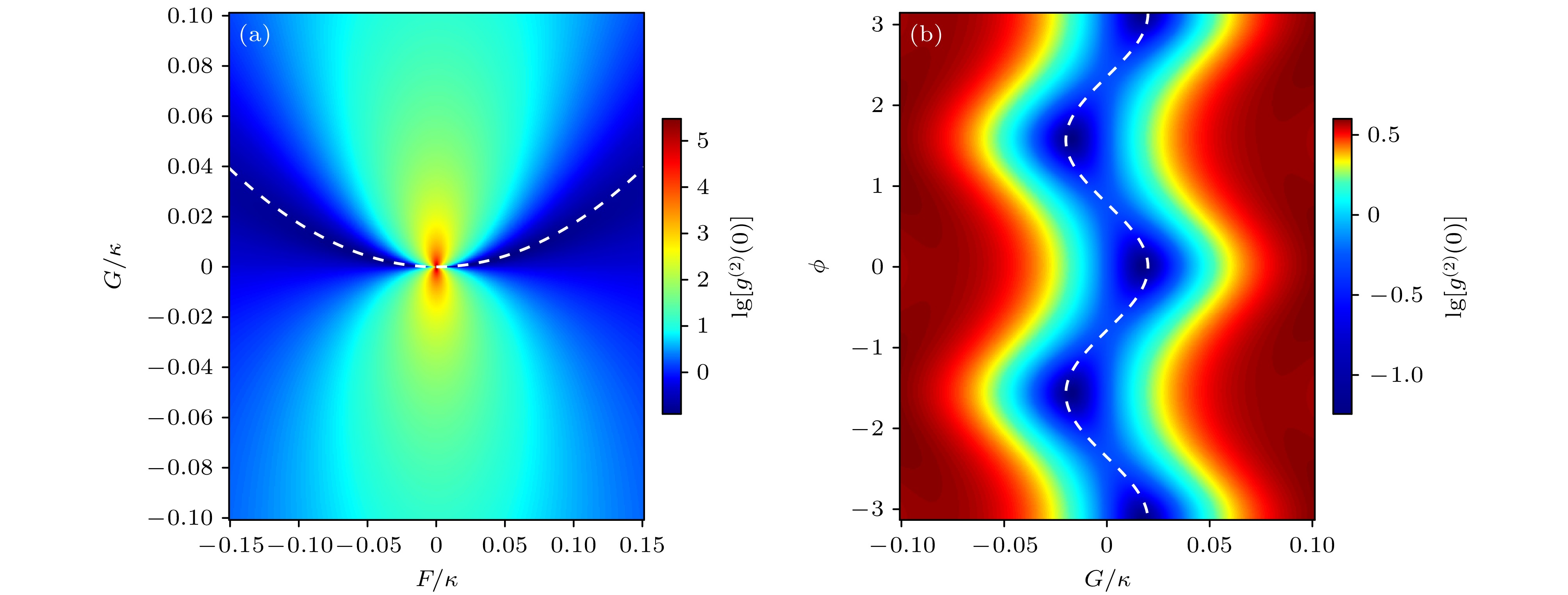
 DownLoad:
DownLoad:
